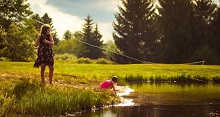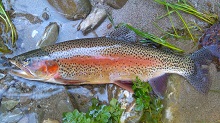Frog Population Estimates May Be Flawed
One of the key species that scientists monitor is amphibian populations, like the frog. One of the major reasons that researchers like to use frogs is that they are extremely sensitive to the environment. They can warn about changes to their habitat that affect them such as pollution, chemicals and other ecological problems. Recently a study by North Carolina State shows that the data that the researchers has been using may be flawed and the population estimates may be incorrect, leading to over estimates of the frog populations.
Frogs are very unique since they have permeable skin. Frogs and amphibians are unique because oxygen can pass through their skins. The oxygen is dissolved in an aqueous film on their skin and then passes to their blood to be transported through their body. This is one reason why their skin must remain wet at all times. This is why environmental toxins will be more noted as it would interfere with the oxygen transfer.
Their life cycle is also unique in that the frogs lay their eggs in ponds, streams, lakes and rivers. The eggs hatch as tadpoles and their first part of their life cycle is spent in the water. As the tadpole ages, it gets larger and start to develop lungs.
Scientists have learned that amphibians are environmental indicators that respond very quickly to pollution and environmental degradation. “Understanding changes in amphibian populations can help us identify potential environmental problems,” says Dr. Ted Simons, a professor of biology at NC State, co-author of the new study, and assistant unit leader at the U.S. Geological Survey (USGS) Cooperative Fish and Wildlife Research Unit.
The NAAMP uses volunteers to go to designated locations to estimate frog populations and report their finds to the USGS. The volunteers listen for frogs mating calls, which species and reports on a rough estimate of population size.
Dr. Simons and his co-authors wanted to find out how accurate these estimates were and used a system called “Ribbit Radio” that had been previously used for census on birds. The researchers set up the “Ribbit Radio” in a field and used it to see how well the volunteers could recognize the species and the population estimates. Researchers noted that the volunteers noted a lot of false positives in the data. “A lot of it is human nature,” Dr. Simons says. “Observers want to include as many species on their lists as possible, but sometimes our ears play tricks on us.”
This is a major problem for the NAAMP, since they rely on the data collected by the volunteers to estimate frog populations. Since there is a significant amount of false positives, the population estimates may be flawed and changes in the populations may not be noted until there is further damage to the species. The researchers are hoping that better training of the volunteers will give a more accurate estimate of population densities. Simons notes. “Training observers to help reduce false positive errors should improve the quality of the monitoring data,” he says.
“Dr. Simons’ work adds to our understanding of observer error in frog call surveys and more research on this topic is needed,” says Linda Weir, USGS NAAMP Coordinator and one of the participants in the study. Dr. Simons and NAAMP will continue working together this fall on a follow-up study using “Ribbit Radio.”
Wayne Sheridan



